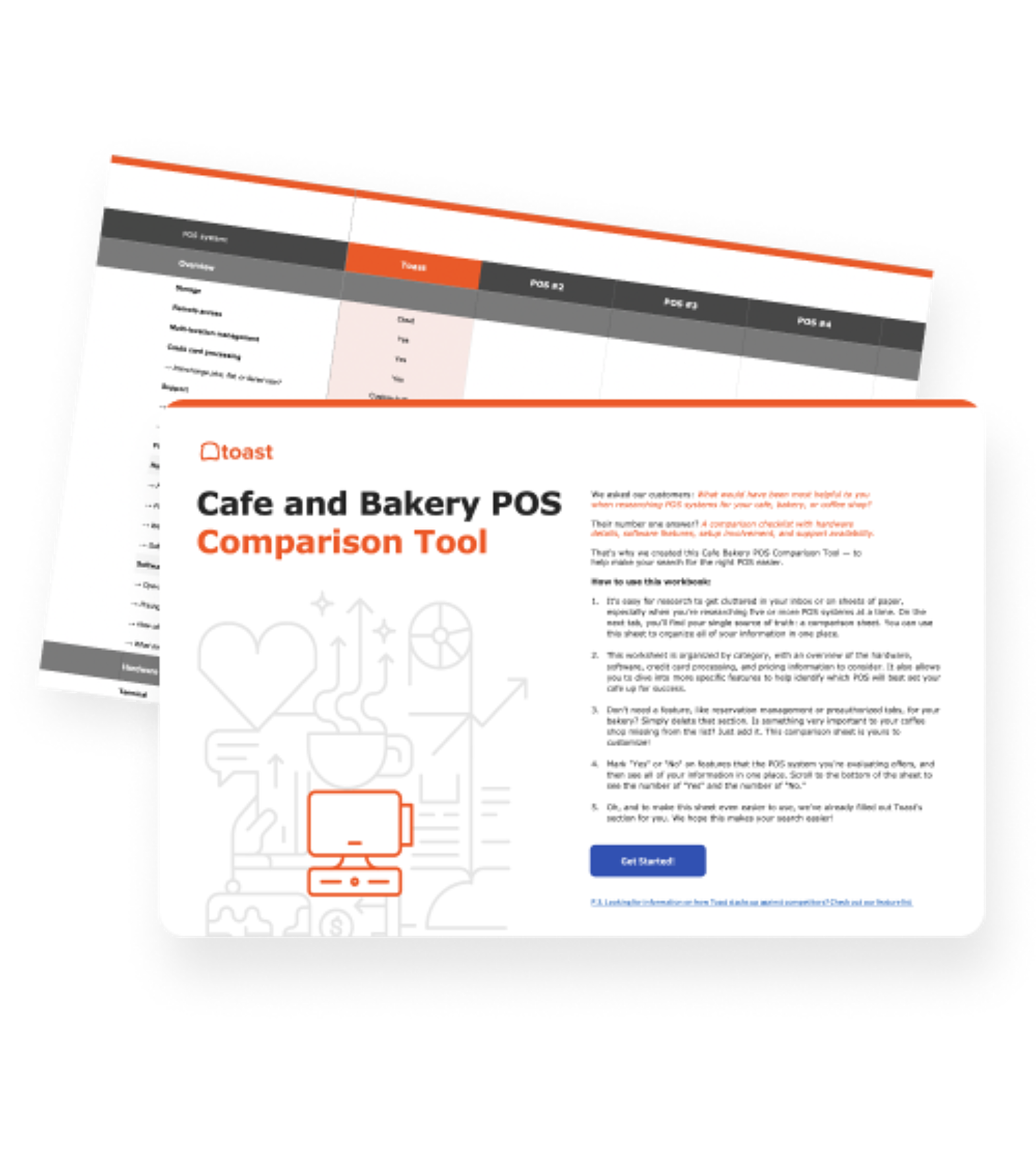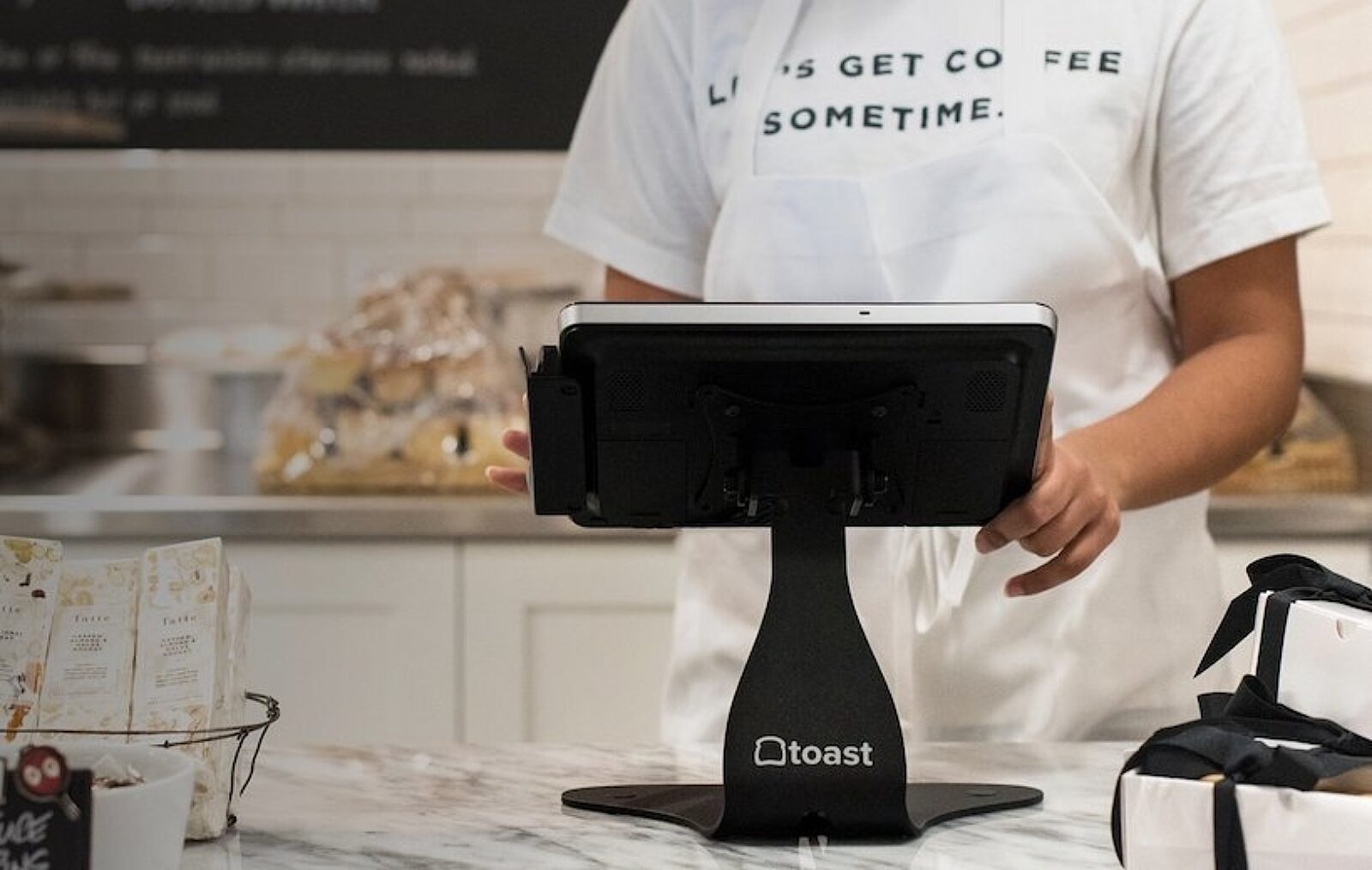
The Best Cafe Software for 2024
Investing in the right cafe software is a necessity for cafes aiming to thrive in today's competitive landscape.

Caroline PriceAuthor


Cafe and Bakery POS Comparison Tool
A free, customizable Cafe and Bakery POS Comparison Tool to research and compare point of sale systems in one Excel spreadsheet or editable PDF.
Get free downloadIn today's fast-paced digital world, cafe software has become an indispensable tool for modern eateries. These innovative technologies encompass various digital solutions designed to streamline and enhance various aspects of restaurant operations, from order management and inventory tracking to customer relationship management and analytics. By leveraging these powerful tools, cafes and restaurants can significantly improve their efficiency, reduce costs, and elevate the overall dining experience for their patrons.
Why is Cafe Software Valuable?
The hospitality industry is undergoing a rapid transformation, with technology playing a pivotal role in shaping its future. As competition intensifies and customer expectations evolve, adopting the right software solutions has become crucial for staying ahead in this dynamic market.
“Owning and operating a small business is a numbers game. Software fills operational gaps in coffee shops, from employee payroll to monitoring green coffee inventory and usage,” wrote Anne Mercer in freshcup.com. Restaurant owners and managers who embrace these digital tools are better equipped to navigate challenges, capitalize on opportunities, and ultimately drive growth in their businesses.
“Beyond the essentials, numerous apps and types of software can provide immediate and long-term benefits,” Mercer adds. “Online ordering apps increase daily revenue, loyalty program software builds community while driving repeat orders, and digital marketing platforms extend promotional opportunities through various sales and communications channels.”
Clearly, the value of cafe software extends far beyond simple automation of tasks. By implementing these solutions, cafes and restaurants can realize a multitude of benefits that directly impact their bottom line and customer satisfaction:
Increased operational efficiency: As emphasized in the Daily Grind, efficiency increases productivity. Automating routine tasks such as order taking, inventory management, and staff scheduling frees up valuable time for managers and employees to focus on more critical aspects of the business.
Enhanced customer experience: Digital ordering systems, loyalty programs, and personalized marketing campaigns enabled by restaurant software can significantly improve customer engagement and satisfaction.
Data-driven decision making: Advanced analytics tools provide valuable insights into sales trends, customer preferences, and operational performance, enabling managers to make informed business decisions.
Reduced errors and waste: Automated inventory tracking and recipe management help minimize food waste and ensure consistent quality across menu items.
Improved staff productivity: With streamlined processes and better communication tools, employees can work more efficiently and provide better service to customers.
How to Evaluate Cafe Software
When evaluating software options, it's helpful to create a scoring system based on certain criteria, according to Forbes Advisor. This allows you to objectively compare different solutions and make an informed decision.
Features and functionality: Assess whether the software offers the specific tools and capabilities your cafe needs, such as POS systems, inventory management, or online ordering.
Ease of use: Look for intuitive interfaces and user-friendly designs that require minimal training for staff to adopt.
Integration capabilities: Ensure the software can seamlessly integrate with your existing systems and third-party applications, such as accounting software or delivery platforms.
Scalability: Choose a solution that can grow with your business and accommodate future expansion plans.
Customer support: Evaluate the level of technical support and training provided by the software vendor.
Security and compliance: Verify that the software meets industry standards for data security and regulatory compliance.
Cost-effectiveness: Consider the total cost of ownership, including initial setup, ongoing subscription fees, and potential hardware requirements.
Cafe and Bakery POS Comparison Tool
A free, customizable Cafe and Bakery POS Comparison Tool to research and compare point of sale systems in one Excel spreadsheet or editable PDF.

How to Choose the Right Cafe Software
Selecting the ideal software for your cafe requires a thoughtful and systematic approach, including identifying what features are most essential to you. Follow these steps to ensure you choose a solution that aligns with your business needs:
Identify your specific needs and goals: Before exploring software options, clearly define your cafe's pain points and objectives. Are you looking to streamline order processing, improve inventory management, or enhance customer loyalty? Creating a prioritized list of requirements will help guide your search.
Research available options: Conduct thorough research on different cafe software solutions, reading reviews, watching demo videos, and consulting with industry peers to gather insights on various platforms.
Create a shortlist: Based on your initial research, narrow down your options to a handful of software solutions that seem to best fit your needs.
Request demos and trials: Reach out to vendors for live demonstrations and, if possible, request trial periods to test the software in your actual cafe environment.
Evaluate user experience: Pay close attention to the software's interface and ease of use during demos and trials. Consider how quickly your staff can learn and adapt to the new system.
Assess integration capabilities: Ensure the software can seamlessly integrate with your existing systems, such as accounting software or third-party delivery platforms.
Consider scalability: Choose a solution that can grow with your business and accommodate future expansion plans.
Review support and training options: Evaluate the level of technical support and training provided by the software vendor to ensure smooth implementation and ongoing use.
Analyze costs and ROI: Calculate the total cost of ownership, including initial setup, ongoing subscription fees, and potential hardware requirements. Estimate the potential return on investment based on anticipated improvements in efficiency and revenue.
Make an informed decision: Based on your evaluation, select the software that best meets your needs, budget, and long-term business goals.
Essential Features to Look For in Cafe Software
"You need data to help improve your business. I look at our sales compared to last year's sales almost every day,” shared owner of Spoken Cafe, Will Goodwin. There are multiple must-have software features that are essential to the success of a growing cafe. Remember that the ideal software solution should not only meet your current needs but also have the flexibility to adapt to your cafe's growth and changing market conditions.
Point of Sale (POS) system
Inventory management
Menu management
Table management and reservations
Employee scheduling and management
Reporting and analytics
Customer relationship management (CRM)
Online ordering and delivery integration
Kitchen display system
Loyalty program management
How Much Can You Expect to Pay for Cafe Software?
On average, you can expect to pay anywhere from $50 to $200 per month per terminal for a basic POS system, with more comprehensive solutions ranging from $200 to $500 or more per month. Additional costs may include setup fees, hardware purchases, and add-on features.
Cafe software pricing can vary significantly based on several factors, including the features offered, the size of your business, and the pricing model used by the vendor. Common pricing models include:
Subscription-based: Monthly or annual fees based on the number of terminals or users.
Per-transaction fees: A percentage of each sale processed through the system.
Tiered pricing: Different feature sets and support levels at various price points.
Hardware costs: One-time purchases or leasing options for POS terminals and other equipment.
How to Budget for Cafe Software
It helps to first have an understanding of the profit potential of your cafe in the first place, when estimating how software can bolster your bottom line. Here are other ways to strategically ensure that it fits into your budget.
Calculate potential ROI: Estimate the time and money saved through increased efficiency and reduced errors to justify the investment.
Start small and scale: Begin with essential features and add more as your business grows and your needs evolve.
Look for bundled packages: Some vendors offer discounts for combining multiple features or services.
Negotiate with vendors: Don't hesitate to ask for better pricing, especially for long-term commitments or multiple locations.
Consider total cost of ownership: Factor in all associated costs, including training, support, and potential hardware upgrades.
Explore financing options: Some vendors offer payment plans or financing to help manage upfront costs.
Toast for Cafes: Built for whatever you're brewing up next
Leveraging the right cafe software is crucial for streamlining operations, enhancing customer experiences, and staying competitive in today's digital-first world. By carefully evaluating your needs and exploring the various options available, you can find a solution that not only addresses your current challenges but also supports your long-term growth objectives.
Among the many excellent options in the market, Toast stands out as a leading solution for cafes and restaurants of all sizes. Toast offers a comprehensive suite of features designed to address the diverse needs of modern eateries, including:
Robust POS system with customizable menu management
Integrated online ordering and delivery capabilities
Advanced inventory tracking and recipe costing
Powerful reporting and analytics tools
Employee management and payroll integration
Customer relationship management and loyalty programs
Contactless payment options and mobile ordering
What sets Toast apart is its user-friendly interface, which minimizes the learning curve for staff and ensures smooth adoption. Additionally, Toast's cloud-based architecture allows for real-time updates and seamless integration with a wide range of third-party applications, providing flexibility and scalability as your business grows.
With Toast, you can serve up coffees or pastries fast with easy and efficient tools, all at your fingertips. From 24/7 reliability to flexible options for every budget, here's to finally getting that me time back.
In conclusion, investing in the right restaurant software is no longer a luxury but a necessity for cafes and restaurants aiming to thrive in today's competitive landscape. By leveraging powerful tools like Toast, you can optimize your operations, enhance customer satisfaction, and position your business for long-term success in the ever-evolving restaurant industry.
Related Resources
Is this article helpful?
DISCLAIMER: This information is provided for general informational purposes only, and publication does not constitute an endorsement. Toast does not warrant the accuracy or completeness of any information, text, graphics, links, or other items contained within this content. Toast does not guarantee you will achieve any specific results if you follow any advice herein. It may be advisable for you to consult with a professional such as a lawyer, accountant, or business advisor for advice specific to your situation.
Read More
Subscribe to On the Line
Sign up to get industry intel, advice, tools, and honest takes from real people tackling their restaurants’ greatest challenges.



